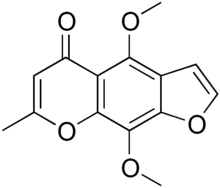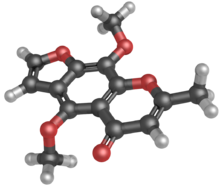Khellin
Topic: Chemistry
 From HandWiki - Reading time: 5 min
From HandWiki - Reading time: 5 min

| |

| |
| Names | |
|---|---|
| Preferred IUPAC name
4,9-Dimethoxy-7-methyl-5H-furo[3,2-g][1]benzopyran-5-one | |
| Other names
Amicardine; Corafurone; Methafrone; Kelourin; Rykellin; Visammin ; Ammispasmin; Ammivisnagen; Gynokhellan; Interkellin; Interkhellin; Amikellin; Ammipuran; Benecardin; Deltoside; Kelicorin; Khelangin; Khellamine; Khellanals; Khellinorm; Medekellin; Visammimix; Viscardan; Visnagalin; Kalangin; Kelincor
| |
| Identifiers | |
3D model (JSmol)
|
|
| ChEMBL | |
| ChemSpider | |
| EC Number |
|
| KEGG | |
| MeSH | C438920 |
PubChem CID
|
|
| UNII | |
| |
| |
| Properties | |
| C14H12O5 | |
| Molar mass | 260.245 g·mol−1 |
| Appearance | colorless needle-shaped crystals |
| Melting point | 154-155 C |
Except where otherwise noted, data are given for materials in their standard state (at 25 °C [77 °F], 100 kPa). | |
| Infobox references | |
Khellin has been used as an herbal folk medicine, with use in the Mediterranean dating back to Ancient Egypt, to treat a variety of maladies including: renal colic, kidney stones, coronary disease, bronchial asthma, vitiligo, and psoriasis.[1] It is a major constituent of the plant Ammi visnaga, also known as Bishop's Weed. Once purified, khellin exists as colorless, odorless, bitter-tasting needle-shaped crystals[2] and is classified as a gamma-pyrone, a furanochromone derivative. In the early 20th century, researchers searched for khellin analogs with lower toxicity and better efficacy. A number of drugs were discovered through this research, such as amiodarone and cromolyn sodium, which are used in current medical practice. Efloxate is also mentioned as analog.[3]
Background
Khellin is found in Egypt, the Middle East, and areas surrounding the Mediterranean. It is a major constituent of the plant Ammi Visnaga, existing between 0.3 and 1.2% in the leaves and seeds.[4] Bishop's Weed is a name given to several species of plants; however, only Ammi Visnaga contains khellin. Khellin is rarely found in its pure form; instead it is found in Ammi Visnaga or "Khella" extract. As a result, many healing properties have been attributed to Khellin that are actually due to other constituents in the extract. Ammi Visnaga preparations are commercially available and very common; however, the amount of Khellin and other ingredients varies greatly between brands and even batches of the same brand. The extract is commonly found as a tea or in a pill form.
Medical use
Therapeutic use is often not recommended, as the risks often outweigh the benefits. Regardless of this recommendation, Ammi Visnaga is still often used in the Middle East, Egypt, and surrounding areas. Unwanted side effects include dizziness, reversible cholestatic jaundice, pseudoallergic reaction, and elevated levels of liver enzymes (transaminases and gamma-glutamyltransferase).[5]
Vitiligo
Vitiligo is a disease which causes loss of pigmentation in portions of skin. When khellin is applied topically in combination with UVA light, it is able to stimulate melanocytes (cells that produce melanin) in hair follicles for successful treatment of vitiligo. One such method is blister roof transplantation; in which, blisters are formed on an unaffected area and are then grafted onto a vitiligo affected area. When khellin is applied topically and treated with UV light, pigmentation returns to treated areas.[6] When taken systemically, khellin induces elevated liver enzyme levels and broad photosensitivity; however, topical application reduces these side effects. Psoralens are commonly used for vitiligo treatment, but have higher phototoxic and DNA mutagenic effects. While Khellin treatment in conjunction with UV therapy is successful, accelerated photoaging and increased risk of skin cancer is another concern.[7]
Kidney stones
When ammi visnaga extract is taken daily, as a tea or as a pill, calcium oxalate kidney stone formation is inhibited, making it a good treatment for hyperoxaluria (a condition in which there is excessive oxalate excretion in the urine, causing kidney stones). Khellin was thought to slow or prevent calcium oxalate nucleation, preventing stones from forming. However, studies have shown that khellin is not the active ingredient in Ammi Visnaga extract. Upon studying calcium oxalate nucleation, ammi visnaga extract as a whole was shown to prolong nucleation time as well as change stone conformation, while khellin alone had no effect.[8][9]
Khellin has also been used to treat renal colic, which is due mostly to schistosomiasis infections and stone formation. The plant mixture had diuretic properties that were seen to relieve renal colic by relaxing the ureter and acting as a diuretic.
Other
Intramuscular injections of khellin can also be used to treat asthma. Khellin acts as a bronchodilator; however, the common side effects including nausea present difficulties.[10]
Khellin has been used to relieve the pain associated with angina pectoris by acting as a selective coronary vasodilator.[11] This can be done either orally or intramuscularly; however nausea is a major side effect regardless of how the medication is taken.[12]
See also
- Ammi (plant)
- Amikhelline, an antimitotic drug
- Visnagin
References
- ↑ Azim Khan, Muhammad (2014). "Phytochemistry and Medicinal Properties of Ammi Visnaga". Pak. J. Bot. 46 (3): 861–867.
- ↑ Shinde, P B; Laddha, K S (March 2014). "Development of new isolation technique and validated HPLC method development for khellin". Indian Journal of Natural Products and Resources 5 (1): 40–43.
- ↑ Dewar, H. A.; Horler, A. R.; Newell, D. J. (1959). "A Clinical Trial of Penta-Erythritol Tetranitrate, A Khellin Derivative (Recordil), and Iproniazid in Angina of Effort". Heart 21 (3): 315–322. doi:10.1136/hrt.21.3.315. ISSN 1355-6037. PMID 13816307.
- ↑ Mesbah, M.K. (1992). "Determination of Khellin and Visnagin in Ammi visnaga fruits and in renal teas by HPLC". Egypt. J. Pharm. Sci. 33 (5–6): 897–904.
- ↑ Blumenthal, M; Busse, W.R.; Goldberg, A.; Gruenwald, J.; Hall, T.; Riggins, C.W.; Rister, R.S (1998). The complete German commission monographs, therapeutic guide to herbal medicines.
- ↑ Leeuw, J de; Assen, YJ; Bjerring, P; Neumann, HA Martino (2011). "Treatment of vitiligo with khellin liposomes, UV light and blister roof transplantation". J Eur Acad Dermatol Venereol 25 (1): 74–81. doi:10.1111/j.1468-3083.2010.03701.x. PMID 20477914.
- ↑ Plettenberg, Heidi; Assmann, Till; Ruzicka, Thomas (2003). "Childhood vitiligo and tacrolimus". Arch. Dermatol. 139 (5): 651–654. doi:10.1001/archderm.139.5.651. PMID 12756103.
- ↑ Vanachayangkul, P.; Chow, N.; Khan, S. R.; Butterweck, Veronika (2011). "Prevention of renal crystal deposition by an extract of Ammi visnaga L. and its constituents khellin and visnagin in hyperoxaluric rats". Urol. Res. 39 (3): 189–195. doi:10.1007/s00240-010-0333-y. PMID 21069311.
- ↑ Abdel-Aal, E.A.; Daosukho, S.; El-Shall, H. (2009). "Effect of supersaturation ratio and Khella extract on nucleation and morphology of kidney stones". Journal of Crystal Growth 311 (9): 2673–2681. doi:10.1016/j.jcrysgro.2009.02.027. Bibcode: 2009JCrGr.311.2673A.
- ↑ Kennedy, M.C.S; Stock, J.P.P (1952). "The bronchodilator action of khellin". Thorax 7 (1): 43–65. doi:10.1136/thx.7.1.43. PMID 14913500.
- ↑ Osher, Harold; Katz, Kermit; Wagner, Donald (1951). "Khellin in the treatment of angina pectoris". The New England Journal of Medicine 244 (9): 315–321. doi:10.1056/nejm195103012440901. PMID 14806755.
- ↑ Conn, James J. (1952). "The treatment of angina pectoris with khellin". Annals of Internal Medicine 36 (5): 1173–1178. doi:10.7326/0003-4819-36-5-1173. PMID 14924454.
External links
 |
 KSF
KSF